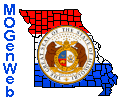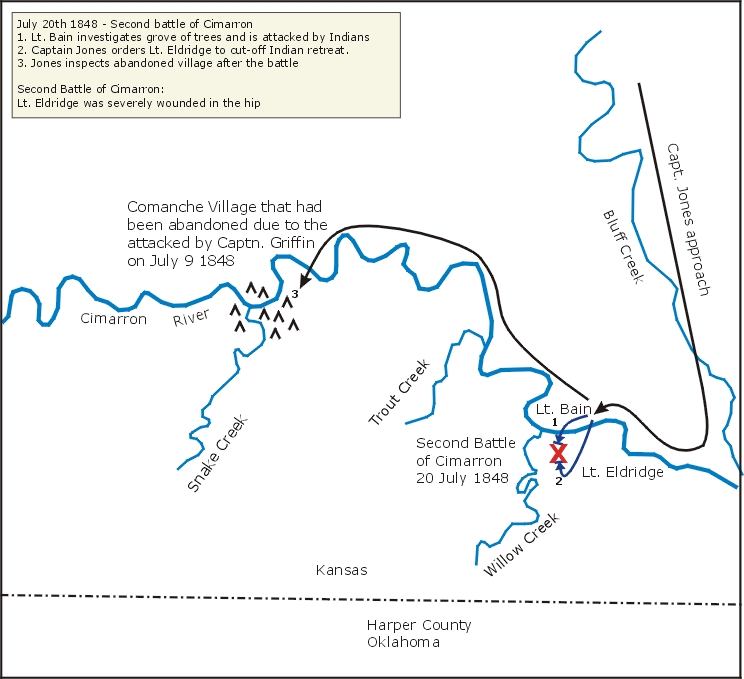

The afternoon of July 12th 1848 found Colonel William Gilpin and his battalion of Missouri Mounted Volunteers encamped at Fort Mann, which was located at present day Dodge City Kansas. Captains John C. Griffin and Gabriel de Korponay had just returned to the fort and both have reports of major engagements with Indians. Captain Griffin reports on the First Battle of Cimarron River which took place on July 9th 1848, and Captain Korponay reports on his battle of July 10th 1848 fought on the banks of the Arkansas River against five or six hundred warriors. These reports confirmed that not only were there Indians in the vicinity, there were at least two encampments of Indians. Both reports indicated that the Indians had been forced to the southeast, but had they been driven away, or had they moved out of site just to return and resume their raids along the Santa Fe Trail? Col. Gilpin needed answers.
On July 15th 1848 Col. Gilpin issued orders to Captain Thomas Jones, commander of Company B of cavalry 1, to take his company with reinforcements from Company A and a six-pounder howitzer, and to proceed east along the Trail until they reached the south bend of the Arkansas. This was site where Korponay had fought his battle with the Indians. If no Indians were found, they were to turn south and reconnoiter the area of the First Battle of Cimarron. If Jones encountered Indians, he was ordered to engage them at once. Jones left at noon on July 15th 1848 and proceeded east along the trail. On the evening of July 16th 1848, Jones and his detachment encountered a west bound train of the traders of Bullard and Hooke who convinced Captain Jones that there were no Indians on the trail east of them. This swayed Captain Jones to turn south toward the Cimarron, and destiny. For had this not happened, I would not be here today, and you would not be reading this.
Captain Jones arrived on the banks of the Cimarron just east of where the First Battle of Cimarron had occurred on the morning of July 20th 1848. Jones had 108 men and officers under his command, sixty-seven from Company B under First Lieutenant Joseph C. Eldridge, sixteen men from Company A under Lieutenant Bain and fifteen men of artillery from Company C, and seven civilian and scouts, including the Indian guide Micheau Duvall.
At about 10:00 a.m. Micheau, who had been scouting ahead of the column, came galloping back with the news that he had seen Indians in a stand of trees not far ahead of the column. Captain Jones reorganized his troops and prepared them for battle. He placed thirty men under the command Lt. Bain to act as cavalry, and thirty men on horses and mules under the commanded by Lt. Eldridge to act as mounted rifles to support Lt. Bain. Captain Jones arranged his troops so as to hide the howitzer, which the Indians had learned to fear. As they approached the stand of trees where Micheau had seen the Indians, Captain Jones noticed a warrior on a sand dune behind the grove of trees trying to draw them away. Captain Jones ordered Lt. Bain, and his thirty men, to reconnoiter the grove of trees and to determine the intention of the Indians. Lt. Bain and his men crossed the river, and came under attack as they entered the tree grove. Captain Jones at once ordered Lt. Eldridge to circle behind the grove of trees, and attack from the rear. Captain Jones' swift action assured that the Indians did not have an avenue of retreat. A very sound military maneuver. Lieutenants Eldridge and Bain had sufficient resources to contain the situation in the tree grove, and Jones still had reserves and a howitzer at his disposal to deal with any new threats that may have appeared.
When Lt. Eldridge reached the back of the tree grove, he and his men plowed headlong into the retreating Indians, who by now had realized how serious their situation had become. With the appearance of Lt. Eldridge and his men at their rear they were now cut off, and surrounded. Due to this fact, the heaviest fighting occurred at the back of the tree grove, where Lt. Eldridge and his troops had entered. As a result, the troops under Lt. Eldridge's command took the heaviest casualties.

Having the Indians trapped between them, Lieutenants Eldridge and Bain quickly brought the fighting to an end. After the battle, Jones rode into the abandoned village and made note that it had been abandoned very quickly, and that there were supplies spilled from their hasty retreat.
This battle leaves some unanswered questions. It was reported the the Indians were Pawnee, but Pawnee usually never ventured this far south in so few numbers, and where were the Indians horses? Plains Indians always fought from horse back.
Captain Jones later wrote of the battle:
"The Comanches appear to have been effectually driven from the Arkansas, and to have retreated in the direction of the lower Canadian. Columns of smoke were seen by us, both going and returning, in the eastern horizon, indicating the presence, or passage of Indians. These were probably the retreating Comanches. or by hunting parties of Osage or Kansas Indians, near the great bend of the Arkansas."
I can image what it was like in 1848 with vast herds of buffalo, large bodies of Indians moving up and down the wide open prairie. I'm sure with the great columns of smoke rising in the east that the sunrise must have been something to behold.
Lt. Joseph C. Eldridge spent the rest of his life with the arrow head embedded in his hip, which forced him to walked with a limp and caused him "much suffering".
In my opinion, the difference between the first and second battle of Cimarron River was that Captain Jones had a scouting report of the enemy disposition, and a battle plan before he got to the battle site. Captain Griffin did not. He arrived at the battle site unprepared with no prior scouting of the Indians position. Therefore, Griffins attack was far less effective than Captain Jones' attack.
The
Dallas County MOGenWeb
site is maintained by
Comments and contributions are welcome.
Many thanks to previous coordinators Carmen Boyd and Megan Zurawicz.
Copyright © 1997-2024, all rights reserved.
Last updated:
Wednesday, 22-Oct-2008 20:57:25 MDT